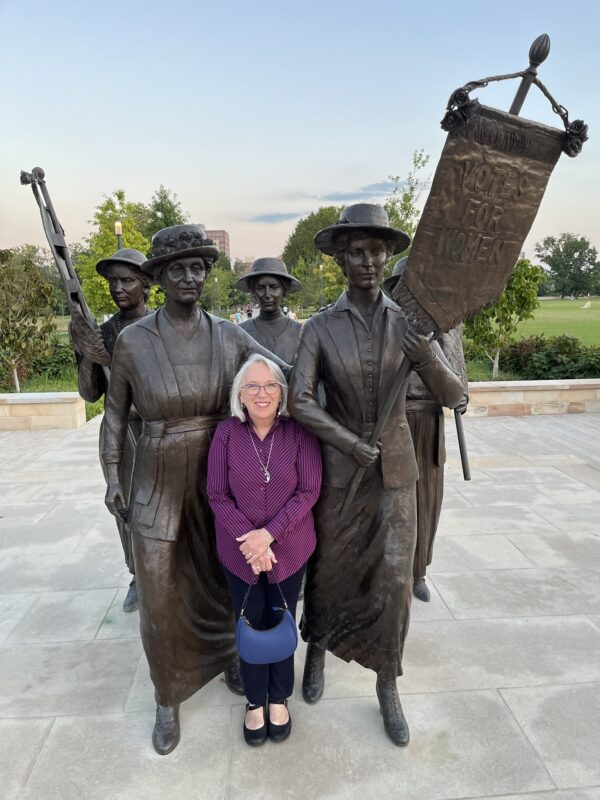When a Legislator Listened to His Mama
I love this picture that John chose to illustrate the opening page of Unit 9 in Exploring Government, which teaches about the 4th through the 27th Amendments to the U.S. Constitution. It is one of my favorite illustrations. The hats, the skirts and blouses, the flags, and especially the baby in the baby carriage are so fun. It is a great illustration for the 19th Amendment, which granted women across America the right to vote in federal elections.

Woman Suffrage Parade in New York City, May 1912
While we were in Nashville, Ray and I saw continual reminders of the ratification of the 19th Amendment. Ratification by the legislatures of 36 states was required for the amendment to become part of the Constitution. Thirty-five state legislatures had ratified it before President Woodrow Wilson pressured Tennessee governor A. H. Roberts to call a special session of the state legislature in August of 1920 to bring the issue to a vote.
American woman suffragists had been working to gain the right to vote for decades. The National American Woman Suffrage Association had adopted yellow and white as their signature colors. White represented purity. Notice that the women in the photo above are wearing white. Yellow represented hope. Eventually yellow roses also became a symbol of woman suffrage. Those who opposed suffrage for women wore red roses. Thus the conflict came to be called a “war of the roses.”
People on both sides of the issue came to Nashville for the special session. Suffragists worked for Tennessee to become the “Perfect Thirty-Six.” Anti-suffragists worked to prevent it. Among the supporters in Nashville that summer was Carrie Chapman Catt, who was the most prominent suffragist at the time. She came in July, taking a room in the Hermitage Hotel across the street from the Tennessee state capitol.
Members of the legislature gathered at Nashville’s train station, where supporters of the amendment received yellow roses for their lapels and anti-suffragists received red roses. Legislators were almost evenly divided. On August 17, Mrs. Catt told suffragists that the only thing they had left to do was to pray.
On August 13, the Tennessee state senate voted to approve the amendment. Now it was up to the state house of representatives. The state house met on August 18. Someone made a motion to table the amendment, which would mean that they would not vote on it all: 48 voted to table the amendment and 48 voted to vote on the amendment. They tried again, and the vote was again 48 to 48.
The speaker of the house, who opposed the amendment, called for another vote, but he did not know what was going on in the heart of young legislator Harry T. Burn of Niota, Tennessee. Though Burn wore a red rose on his lapel, something was eating at him. Harry Burn’s mother, Febb Ensminger Burn, had sent him a letter. Here is an excerpt:
Dear Son:
Hurrah and vote suffrage!…Don’t forget to be a good boy and help Mrs. Catt put the “rat” in ratification. Your Mother.
Harry Burn decided to listen to his mother. When the next vote was taken, his name was called and he spoke a quiet “aye.” The vote was 49-47. Governor Roberts signed the Tennessee certificate of ratification of the 19th Amendment. On August 24, he sent a letter to President Wilson, enclosing the certificate. Wilson passed the certificate on to the U.S. Secretary of State. Tennessee had become the Perfect Thirty-Six. Women across America had gained the right to vote.
The day after we moved into Hope Lodge, Ray and I saw this memorial in Centennial Park.

Before Ray’s last radiation treatment on October 26, we made a quick morning trip to the Tennessee state capitol to record a few snippets of Ray talking about government so that our videographer could use them in videos about the updated Exploring Government. We saw this historic marker while returning to our car.

We began Ray’s radiation sojourn with Exploring Government and added just a bit more on the last day. As I have said, life doesn’t stop for a crisis.
When Harry Burn met a crisis and people around the country were watching, he listened to his mother. Who knows how your teaching will affect the lives of your children or even the whole country or world some day? Thank you for teaching them faithfully.
My son, observe the commandment of your father
And do not forsake the teaching of your mother;
Bind them continually on your heart;
Tie them around your neck.
When you walk about, they will guide you;
When you sleep, they will watch over you;
And when you awake, they will talk to you.
Proverbs 6:20-22

